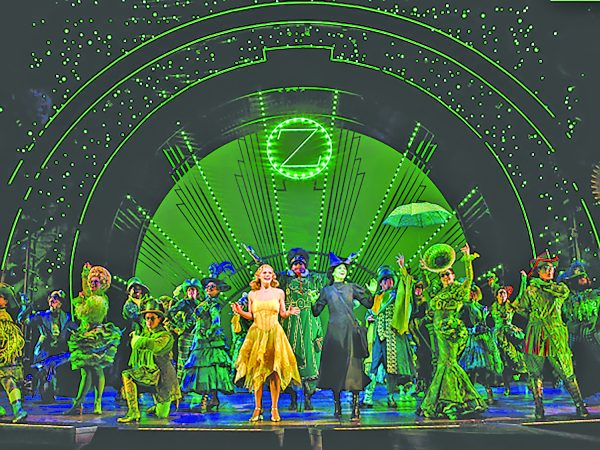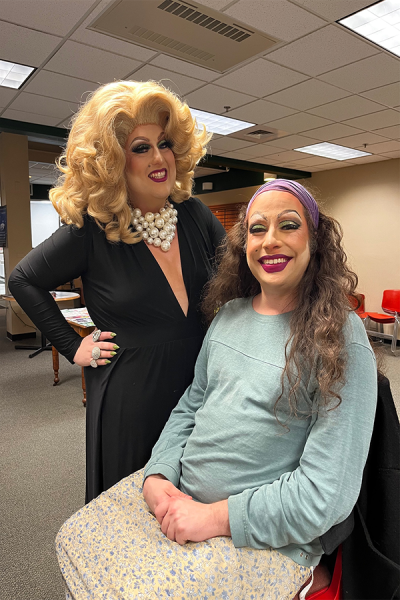An iconic musical comes to Dibden
Cody Logan leads “Sit Down, You’re Rockin’ the Boat”
For their final play of the year, the cast and crew of Dibden brought to life the 1950 musical “Guys and Dolls.”
The play’s main story follows a cast of characters living in New York City during the roaring era of gangsters and gambling. While the play shows its age in some awkwardly sexist overtones, the story is still a riotous and amusing tale that is great fun to watch.
The show opened with the song “Fugue For Tinhorns,” a group number between Nicely Nicely Johnson (Cody Logan), Benny Southstreet (Dylan Ballou), and Rusty Charlie (Andrew Tascarella). Beginning a trend that continued throughout the show’s group songs, the overlapping lyrics were slightly muddled and difficult to understand. Whether this was due to poor enunciation or simply the fact that multiple people were singing at once is hard to say. (Sound design by Patrick Monaghan.)
Despite the confusing start, the show quickly picked up speed once more of the cast was introduced and the beginning of the plot crept in. With the introduction of Nathan Detroit (Sam Lewis), we learned that most of the cast were gamblers who were looking to him to set up another crap game. His main arc followed his struggle to balance the fact that he had no money to actually set up the game and his 14-year-long engagement to Adelaide (Anna Foster).
The other key player on the gambling scene was Sky Masterson (Josh Baughn), whose bet with Nathan Detroit led him to pursue a “doll” from the nearby mission: Sarah Brown (Samantha Gunn).
Although Lewis’s performance as Nathan was slightly meeker than the character would seem to require, his delivery of the play’s more humorous lines was perfectly cheeky. This was accentuated by his surprisingly consistent Brooklyn accent.
Foster also kept up the accent well, and brought depth and life to a character that would have otherwise been a bit shallow and boring. Despite Adelaide’s belief that she needed to be married to be worth anything and her general distaste for letting Nathan be himself, Foster’s enthusiasm made the role a joy to watch.
The show’s two most annoying songs, “A Bushel and a Peck” and “Take Back Your Mink” — the first for its grating musical choices and the second for its underlying message that women can be bought off with pretty things — were performed by The Hot Box Girls. Adelaide led both performances, and Foster once again brought out the best in an outdated script with her verve and dedication to the role.
Baughn’s performance walked a brilliant line between flippant and sincere, alternating when the script called for it. Sky’s character arc was the most redemptive in the show, and Baughn’s portrayal made this not only believable but also empathetic.
As a member of the mission, Sarah’s role in the story was a fascinating struggle between her dedication to doing God’s work and her growing feelings for one of the sinning gamblers that her mission has been trying so hard to save. Gunn did a beautiful job with this dichotomy, expressing defiance, confusion, and acceptance throughout her performance.
My favorite musical number of the night was, without much competition, “Luck Be A Lady.” Headed by Baughn as he prepared to gamble the future of his relationship with Sarah on a single roll of the dice, this was the only ensemble piece that didn’t become too muddled with multiple voices for me to understand it. This could have been due to better enunciation from Baughn, a different balance of sound, or something else entirely, but it heavily benefitted the song.
The highlights of the show were the general humor of the script and the minor touches added by the cast. Although she had no lines, Mariah Holroyd’s performance as the overly-interested and sympathetic waitress while Nathan and Adelaide argued about marriage was one of the funniest parts of the show.
The primary set location throughout the play was a street in New York City, represented by three building façades: Mindy’s, a bakery; The Save-A-Soul Mission; and The Hot Box, where Adelaide and the other Hot Box Girls performed. During scenes set within the mission, the façade would spin to reveal the interior, and curtains would pull in from the sides to cover the other two buildings. (Set design by Andrew Tascarella, Hannah Publicover, and Carol Wade.)
A city skyline decorated the back of the stage, lit from behind with various colors throughout the show. Although generally subtle and appropriate, the color was particularly noticeable when Sarah, feeling betrayed, slapped Sky and the skyline lit up to mark the moment. (Light design by Thomas Gunn.)
Despite the couple of songs that became earworms and stayed in my head for the next three days — I’m looking at you, “A Bushel and a Peck” — “Guys and Dolls” was a well-executed and fun show that had me laughing through most of it. Each member of the cast put forth an enthusiastic performance, and the crew supplied the frame that made them shine.








